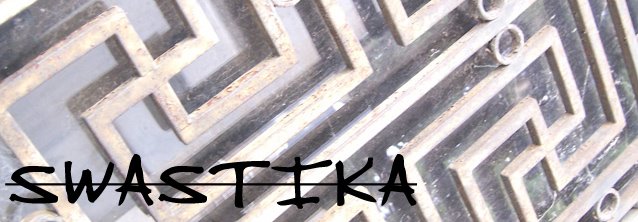Swastika Vai o Kena
Tattoo by Julien Ruiz, Amsterdam.
Vai O Kena or the bath of Kena. Now also know as the Marquesan Cross.
Drawing by Luis and image-cleaning by Pēteris.
Down here the story wich explains most Marquesan designs
Kena's mother, Tiahee, for many years bore premature children, or rather parts of children, arms, legs, trunks, hands, even eyes and ears, were born separately. All of them alive, but none of them complete children. Then at last after long years and sorrow, a boy was born to Tiahee, who was complete as well formed in every respect. Tiu, the father, was overjoyed, and named him Kena, and rejoiced that some day Kena would grow up to be a man, and helper on fishing trips and raising their food crops.
But when he became large, Kena was a very lazy boy, who could not even lift his own body off the ground. After many persuasions and threats, his father finally drove him from his house in anger. As he was leaving, all the pieces of his brothers and sisters cried out to him. His mother had placed them in a basket, hanging under the eaves, and behold, they were still alive, wanting to go with Kena!
So Kena took them and as he went through valley after valley, his bits of brothers and sisters advised and encouraged him. And he became a great hero because he learned to conquer all the little champions in arm bending, spear throwing, and other other tests of manhood. Always it was his brothers and sisters who told him how to position himself and what profits to use. It was because of them that he always won.
Then he went to Taaoa and was married with his beautiful cousin, Tefio and lived there and lived there. One time he went out into the ocean and endulged in playing on his surfboard for days on end. When he came back he was so covered with slimy seaweed that his wife abandoned him with a shutter.
He wandered away, married several other girls from place to place, and at length came to Atuona, where a great chieftain was arranging for his son to be tattooed. Kena was determined to acquire this marvelous decoration and go back with it to Tefio again.
But first he was advised by the women to make himself small, as a little boy, so he would not be noticed. He did this and in seven days received a complete coating of tattoos. This would be impossible for any normal person; such a tattooed suit would take seven years or more. Kena, with his magic, was able to receive it. A long chant with many musical repetitions recites the sequences of the tattoo pattern. On the first day, tattooing of the face. The second day, tattooing of one leg and the foot upward. The third day, tattooing of the other leg from the foot upward. On the fourth day, the tattooing of the neck and breast. The fifth day, tattooing of the sides and arms. Sixth day, the tattooing of the back. Seventh day, tattooing of the buttocks and the filling in of patterns. Each night he covered his new tattoo with soot so that when he was finished he was black all over. Then he would grow back to his own size and go to the home of his father and mother. There he built himself a large square bath of stones just in the center of a fine mountain stream, washed himself and went that night to his parents' house. When he arrived outside, a flash of lightning shown forth from the armpit of Kena. The mother said, "Now, what is that?" The father said, "I think it is my son." So he was welcomed home. He had come to take pigs and fish and poi and fruit to Atuona for a great feast to celebrate the end of the tattooing.
The next morning his mother made the rounds of the people of the region and then told Kena. "Go back to Atuona. When the day comes for the offering, the people from here will bring the feast to the ka'ioi, your companions in the tattooing house."
So Kena went and gave the present. And on the morning of the feast the mother adorned her son with the black feather headress of the tropic bird, and a red feather, and with an apron made of an old man's beard, two ivory ear ornaments, a necklace of sperm whale teeth, two finger feathers, and two haired garlands for the ankles. Tefio, his wife, was with all the women, and there was great feasting, dancing, chanting, and song, and the big drum was beaten as they all showed their beautiful tattooed patterns to the multitude. And Kena's was the most beautiful of all. Then, when the end of the night came, Tefio went to the side of Kena. Kena said, "Come to me; are we reunited again?" Tefio said, "Yes."
"Cited from Tricia Allen on Marquesan tattoo, in HardyMark's TATTOOTIME, Art from the Heart.
Subscribe to:
Post Comments (Atom)



No comments:
Post a Comment